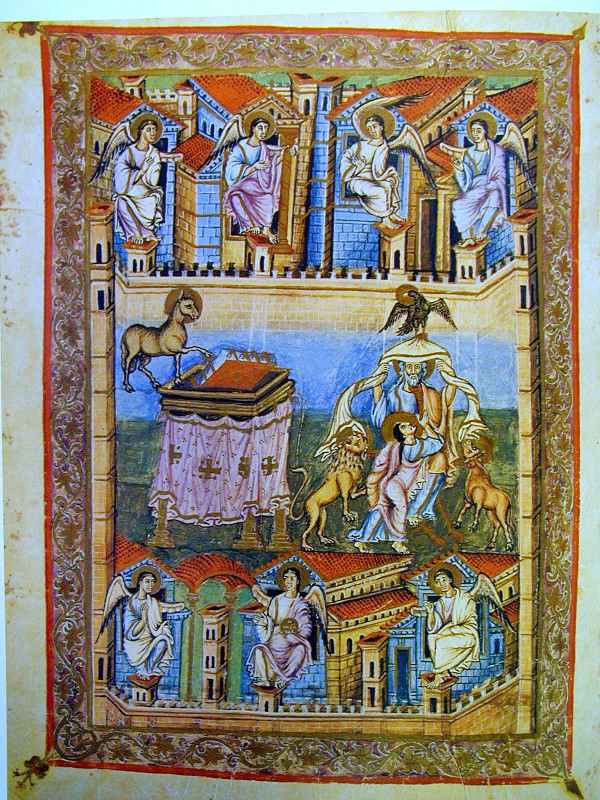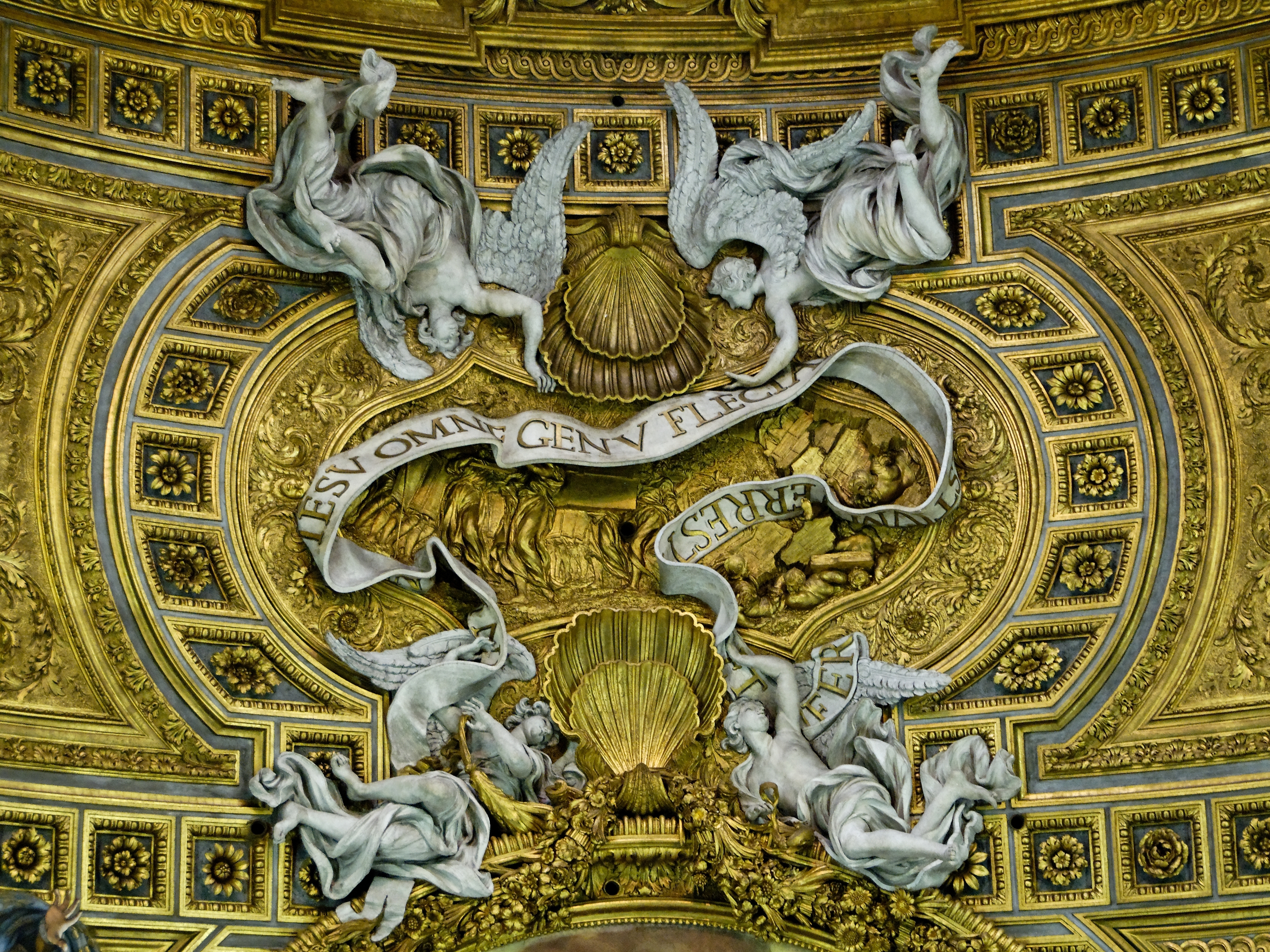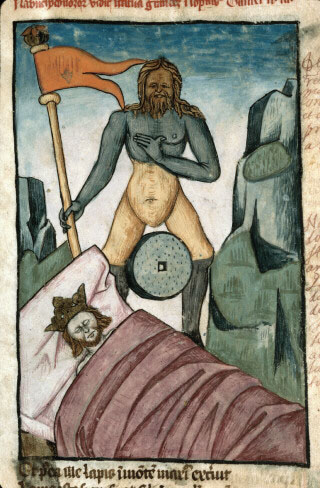|
Revelation 10
Revelation 10 is the tenth chapter of the Book of Revelation or the Apocalypse of John in the New Testament of the Christian Bible. The book is traditionally attributed to John the Apostle, but the precise identity of the author remains a point of academic debate. This chapter and the first part of the next chapter report two episodes which intervene between the sounding of the sixth and seventh trumpets. Text The original text was written in Koine Greek. This chapter is divided into 11 verses. Textual witnesses Some early manuscripts containing the text of this chapter are among others: * Papyrus 115 (ca. AD 275; extant verses 1–4, 8–11) *Papyrus 47 (3rd century; complete) * Papyrus 85 (4th century; extant verses 1–2, 5–9) *Codex Sinaiticus (330-360) *Codex Alexandrinus (400-440) *Codex Ephraemi Rescriptus (ca. 450; extant verses 1–9) Verse 1 :'' I saw still another mighty angel coming down from heaven, clothed with a cloud.'' :''And a rainbow was on his head, his fa ... [...More Info...] [...Related Items...] OR: [Wikipedia] [Google] [Baidu] |
Book Of Revelation
The Book of Revelation is the final book of the New Testament (and consequently the final book of the Christian Bible). Its title is derived from the first word of the Koine Greek text: , meaning "unveiling" or "revelation". The Book of Revelation is the only apocalyptic book in the New Testament canon. It occupies a central place in Christian eschatology. The author names himself as simply "John" in the text, but his precise identity remains a point of academic debate. Second-century Christian writers such as Papias of Hierapolis, Justin Martyr, Irenaeus, Melito of Sardis, Clement of Alexandria, and the author of the Muratorian fragment identify John the Apostle as the "John" of Revelation. Modern scholarship generally takes a different view, with many considering that nothing can be known about the author except that he was a Christian prophet. Modern theological scholars characterize the Book of Revelation's author as " John of Patmos". The bulk of tradition ... [...More Info...] [...Related Items...] OR: [Wikipedia] [Google] [Baidu] |
Codex Sinaiticus
The Codex Sinaiticus ( Shelfmark: London, British Library, Add MS 43725), designated by siglum [Aleph] or 01 (in the Gregory-Aland numbering of New Testament manuscripts), δ 2 (in the von Soden numbering of New Testament manuscripts), or Sinai Bible is a 4th-century Christian manuscript of a Greek Bible, containing the majority of the Greek Old Testament, including the Apocrypha, and the Greek New Testament, with both the Epistle of Barnabas and the Shepherd of Hermas included. It is written in uncial letters on parchment. It is one of the four great uncial codices (these being manuscripts which originally contained the whole of both the Old and New Testaments). Along with Codex Alexandrinus and Codex Vaticanus, it is one of the earliest and most complete manuscripts of the Bible, and contains the oldest complete copy of the New Testament. It is a historical treasure, and using the study of comparative writing styles (palaeography), it has been dated to the m ... [...More Info...] [...Related Items...] OR: [Wikipedia] [Google] [Baidu] |
Names And Titles Of Jesus In The New Testament
Two names and a variety of titles are used to refer to Jesus in the New Testament. In Christianity, the two names Jesus and Emmanuel that refer to Jesus in the New Testament have salvific attributes.''Bible explorer's guide'' by John Phillips 2002 page 147''All the Doctrines of the Bible'' by Herbert Lockyer 1988 page 159 After the crucifixion of Jesus the early Church did not simply repeat his messages, but focused on him, proclaimed him, and tried to understand and explain his message. One element of the process of understanding and proclaiming Jesus was the attribution of titles to him.''Jesus: a Gospel portrait'' by Donald Senior 1992 pages 145-147 Some of the titles that were gradually used in the early Church and then appeared in the New Testament were adopted from the Jewish context of the age, while others were selected to refer to, and underscore the message, mission and teachings of Jesus. In time, some of these titles gathered significant Christological signifi ... [...More Info...] [...Related Items...] OR: [Wikipedia] [Google] [Baidu] |
John's Vision Of The Son Of Man
John's vision of the Son of Man is a vision described in the Book of Revelation ( Revelation 1:9-20) in which the author, identified as John, sees a person he describes as one "like the Son of Man" (verse 13). The Son of Man is portrayed in this vision as having a robe with a golden sash, white hair, eyes like blazing fire, feet like bronze and a voice like rushing waters. He holds seven stars in his right hand and has a double-edged sword coming out of his mouth. The vision is interpreted by Christians as the only identifiable physical description of Jesus in any form in the Christian biblical canon. Account John of Patmos, the author of the Book of Revelation, wrote how on the Lord's Day he was "in the Spirit", and heard a loud voice "like a trumpet" ( Revelation 1:10). When he turned around, he saw this Son of Man figure. In Revelation 1:18, the figure identifies himself as "the First and the Last", who "was dead, and behold I am alive for ever and ever", a reference t ... [...More Info...] [...Related Items...] OR: [Wikipedia] [Google] [Baidu] |
Jesus
Jesus, likely from he, יֵשׁוּעַ, translit=Yēšūaʿ, label=Hebrew/Aramaic ( AD 30 or 33), also referred to as Jesus Christ or Jesus of Nazareth (among other names and titles), was a first-century Jewish preacher and religious leader; he is the central figure of Christianity, the world's largest religion. Most Christians believe he is the incarnation of God the Son and the awaited Messiah (the Christ) prophesied in the Hebrew Bible. Virtually all modern scholars of antiquity agree that Jesus existed historically. Research into the historical Jesus has yielded some uncertainty on the historical reliability of the Gospels and on how closely the Jesus portrayed in the New Testament reflects the historical Jesus, as the only detailed records of Jesus' life are contained in the Gospels. Jesus was a Galilean Jew who was circumcised, was baptized by John the Baptist, began his own ministry and was often referred to as "rabbi". Jesus debated with fellow ... [...More Info...] [...Related Items...] OR: [Wikipedia] [Google] [Baidu] |
Book Of Daniel
The Book of Daniel is a 2nd-century BC biblical apocalypse with a 6th century BC setting. Ostensibly "an account of the activities and visions of Daniel, a noble Jew exiled at Babylon", it combines a prophecy of history with an eschatology (a portrayal of end times) both cosmic in scope and political in focus, and its message is that just as the God of Israel saves Daniel from his enemies, so he would save all Israel in their present oppression. The Hebrew Bible includes Daniel in the '' Ketuvim'' (writings), while Christian biblical canons group the work with the Major Prophets. It divides into two parts: a set of six court tales in chapters 1–6, written mostly in Aramaic, and four apocalyptic visions in chapters 7–12, written mostly in Hebrew; the deuterocanonical books contain three additional sections, the Prayer of Azariah and Song of the Three Holy Children, Susanna, and Bel and the Dragon. The book's influence has resonated through later ages, from the comm ... [...More Info...] [...Related Items...] OR: [Wikipedia] [Google] [Baidu] |
Events Of Revelation
The events of Revelation are the events that occur in the Book of Revelation of the New Testament. An outline follows below, chapter by chapter. Chapters One * The Revelation of Jesus Christ given to John. Two * John addresses the church of Ephesus to repent from having abandoned their first love, or the love they once had. * John addresses the church of Smyrna to warn them of ten days of tribulation that may cost them their lives or imprisonment. * John addresses the church of Pergamum to repent from the doctrines of Balaam and the Nicolaitans. * John addresses the church of Thyatira to repent from the teachings of the prophetess Jezebel. Three * John addresses the church of Sardis for being "dead" or unaware of things to come, whose works are not perfect before God. * John addresses the church of Philadelphia to persevere with what little strength they have; to hold fast so that no one takes their crown. * John addresses the church of Laodicea to repent from investing in m ... [...More Info...] [...Related Items...] OR: [Wikipedia] [Google] [Baidu] |
Last Judgment
The Last Judgment, Final Judgment, Day of Reckoning, Day of Judgment, Judgment Day, Doomsday, Day of Resurrection or The Day of the Lord (; ar, یوم القيامة, translit=Yawm al-Qiyāmah or ar, یوم الدین, translit=Yawm ad-Dīn, label=none) is part of the Abrahamic religions and the '' Frashokereti'' of Zoroastrianism. Christianity considers the Second Coming of Jesus Christ to entail the final judgment by God of all people who have ever lived, resulting in the approval of some and the penalizing of others. The concept is found in all the canonical gospels, particularly in the Gospel of Matthew. The Christian tradition is also followed by Islam, where it is mentioned in the 43rd chapter ('' Az-Zukhruf'') of the Quran, according to some interpretations. Christian futurists believe it will follow the resurrection of the dead and the Second Coming of Jesus, while full preterists believe it has already occurred. The Last Judgment has inspired numerous artistic ... [...More Info...] [...Related Items...] OR: [Wikipedia] [Google] [Baidu] |
Babylon The Great
Babylon the Great, commonly known as the Whore of Babylon, refers to both a symbolic female figure and place of evil mentioned in the Book of Revelation in the Bible. Her full title is stated in Revelation 17 (verse 5) as "Mystery, Babylon the Great, the Mother of Prostitutes and Abominations of the Earth" ( grc, μυστήριον, Βαβυλὼν ἡ μεγάλη, ἡ μήτηρ τῶν πορνῶν καὶ τῶν βδελυγμάτων τῆς γῆς; transliterated ''mystērion, Babylōn hē megalē, hē mētēr tōn pornōn kai tōn bdelygmatōn tēs gēs''). Revelation 17 (verse 18) identifies the woman as a representation of "the great city which reigneth over the kings of the earth". Passages from Revelation The "great whore" of the Book of Revelation is featured in chapter 17: :: — , King James Version Symbolism The Whore is associated with the Beast of Revelation by connection with an equally evil kingdom. The word "Whore" can also be translated met ... [...More Info...] [...Related Items...] OR: [Wikipedia] [Google] [Baidu] |
Euphrates
The Euphrates () is the longest and one of the most historically important rivers of Western Asia. Together with the Tigris, it is one of the two defining rivers of Mesopotamia ( ''the land between the rivers''). Originating in Turkey, the Euphrates flows through Syria and Iraq to join the Tigris in the Shatt al-Arab, which empties into the Persian Gulf. Etymology The Ancient Greek form ''Euphrátēs'' ( grc, Εὐφράτης, as if from Greek εὖ "good" and φράζω "I announce or declare") was adapted from Old Persian 𐎢𐎳𐎼𐎠𐎬𐎢 ''Ufrātu'', itself from Elamite 𒌑𒅁𒊏𒌅𒅖 ''ú-ip-ra-tu-iš''. The Elamite name is ultimately derived from a name spelt in cuneiform as 𒌓𒄒𒉣 , which read as Sumerian is "Buranuna" and read as Akkadian is "Purattu"; many cuneiform signs have a Sumerian pronunciation and an Akkadian pronunciation, taken from a Sumerian word and an Akkadian word that mean the same. In Akkadian the river was called ''Puratt ... [...More Info...] [...Related Items...] OR: [Wikipedia] [Google] [Baidu] |
Selaphiel
Saint Selaphiel the Archangel or Saint Sealtiel, Selatiel, or Selathiel ( Hebrew: שְׁאַלְתִּיאֵל ''Šəʾaltīʾēl,'' Tiberian: ''Šăʾaltīʾēl'', ''"''I have asked God") is one of the archangels in Byzantine Catholic and Eastern Orthodox traditions. Biblical References Selaphiel appears in verse 31:6 of the apocryphal Christian text ''The Conflict of Adam and Eve'', which describes how God sends him and Suriyel to help rescue Adam and Eve from Satan Satan,, ; grc, ὁ σατανᾶς or , ; ar, شيطانالخَنَّاس , also known as Devil in Christianity, the Devil, and sometimes also called Lucifer in Christianity, is an non-physical entity, entity in the Abrahamic religions ...’s deception, commanding Selaphiel “to bring them down from the top of the high mountain and to take them to the Cave of Treasures.” Some Christian traditions consider Selaphiel as the angel in in the New Testament, who presents the prayers of people on ... [...More Info...] [...Related Items...] OR: [Wikipedia] [Google] [Baidu] |
New King James Version
The New King James Version (NKJV) is an English translation of the Bible. The complete NKJV Bible was published in 1982 by Thomas Nelson, now HarperCollins. The NKJV is described by Thomas Nelson as being "scrupulously faithful to the original, yet truly updated to enhance its clarity and readability." History The NKJV translation project was conceived by Arthur Farstad. It was inaugurated in 1975 with two meetings (Nashville and Chicago) of 130 biblical scholars, pastors, and theologians. The men who were invited prepared the guidelines for the NKJV. The aim of its translators was to update the vocabulary and grammar of the King James Version, while preserving the classic style and literary beauty of the original 1769 edition of the King James Version. The 130 translators believed in faithfulness to the original Greek, Aramaic, and Hebrew texts including the Dead Sea Scrolls. Also agreed upon for most New King James Bibles were easier event descriptions, a history of ea ... [...More Info...] [...Related Items...] OR: [Wikipedia] [Google] [Baidu] |







